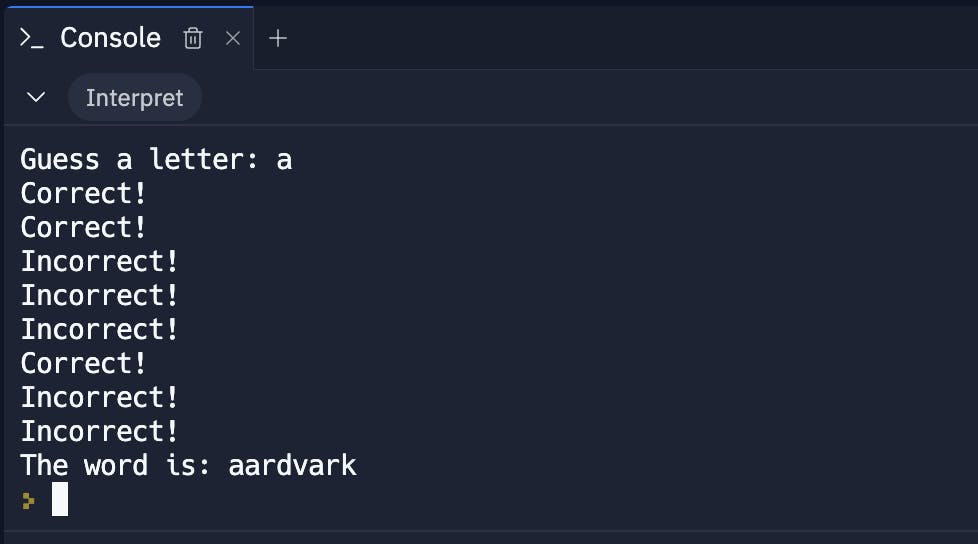Today’s Goals:
Perform a Hangman project, and for this, you need to use For & While Loops, IF/ELSE statements, Lists, Strings, Range, Modules and much more.
What I’ve seen:
📌 I’ve practiced For & While Loops, IF/ELSE statements, Lists, Strings, Range, Modules and much more..
📌 And also I’ve incorporated Flow Chart Programming.
What I Learned Today:
Flow Chart Programming

Flow chart programming is a method of designing and documenting software systems. It’s particularly useful for visualizing the flow of a program or algorithm, making it easier to understand and communicate the logic. Here’s how flow charts are typically used in programming, especially for projects like a Hangman game in Python:
Visual Representation: Flow charts use symbols like rectangles, diamonds, ovals, and arrows to represent different types of actions and decisions. This visual representation helps in understanding the flow of a program.
Planning and Designing: Before writing code, you can use a flow chart to plan the structure of your program. For a Hangman game, this could involve charting out the main gameplay loop, decision points (like checking if a letter is in the word), and the end conditions (winning or losing the game).
Algorithm Development: Flow charts are excellent for developing and refining algorithms. They help you think through each step and decision point in your code.
Debugging and Problem Solving: If you encounter issues while coding, referring to your flow chart can help you identify where the logic might be going wrong.
Communication: Flow charts are a great tool for explaining your code to others, which can be especially helpful in team projects or when seeking help from instructors or peers.
Documentation: A flow chart can serve as part of the documentation for your code, making it easier for others (or yourself at a later time) to understand how your program works.
For instance: In the context of a Hangman game in Python, the flow chart might include the following elements:
Start and End Points: Indicate the beginning and end of your game.
User Input: Represent how the player’s input (guessing letters) is handled.
Process Blocks: Show how the game checks if the guessed letter is in the word, updates the display, keeps track of incorrect guesses, etc.
Decision Points: Indicate where the game decides if the player has won, lost, or if the game continues.
Looping: Since Hangman is a game of repeated guessing, your flow chart should clearly show the loops involved in player input and game response.
Using flow charts in programming is about breaking down a problem into manageable parts and visually mapping out the solution. This approach can be highly effective in learning and mastering programming concepts.
Our real solution:

Let’s Build The Project: Hangman Game
I created the different steps to create the Hangman game:
Step 1:
- Picking a random word and checking the user’s answers.
#Step 1
word_list = ["aardvark", "baboon", "camel"]
#TODO-1 - Randomly choose a word from the word_list and assign it to a variable called chosen_word.
import random
chosen_word = random.choice(word_list)
#TODO-2 - Ask the user to guess a letter and assign their answer to a variable called guess. Make guess lowercase.
guess = input("Guess a letter: ").lower()
#TODO-3 - Check if the letter the user guessed (guess) is one of the letters in the chosen_word.
# if guess in chosen_word:
# print("Correct!")
# else:
# print("Incorrect!")
for letter in chosen_word:
if letter == guess:
print("Correct!")
else:
print("Incorrect!")
print(f"The word is: {chosen_word}")

Step 2:
- Replacing blanks with guesses.
#Step 2
import random
word_list = ["aardvark", "baboon", "camel"]
chosen_word = random.choice(word_list)
#Testing code
print(f'Pssst, the solution is {chosen_word}.')
#TODO-1: - Create an empty List called display.
#For each letter in the chosen_word, add a "_" to 'display'.
#So if the chosen_word was "apple", display should be ["_", "_", "_", "_", "_"] with 5 "_" representing each letter to guess.
display = []
word_length = len(chosen_word)
for _ in range(word_length):
display += "_"
guess = input("Guess a letter: ").lower()
#TODO-2: - Loop through each position in the chosen_word;
#If the letter at that position matches 'guess' then reveal that letter in the display at that position.
#e.g. If the user guessed "p" and the chosen word was "apple", then display should be ["_", "p", "p", "_", "_"].
for position in range(word_length):
letter = chosen_word[position]
#print(f"Current position: {position}\n Current letter: {letter}\n Guessed letter: {guess}")
if letter == guess:
display[position] = letter
#TODO-3: - Print 'display' and you should see the guessed letter in the correct position and every other letter replace with "_".
#Hint - Don't worry about getting the user to guess the next letter. We'll tackle that in step 3.
print(display)

Step 3:
- Checking if the player won.
#Step 3
import random
word_list = ["aardvark", "baboon", "camel"]
chosen_word = random.choice(word_list)
word_length = len(chosen_word)
#Testing code
print(f'Pssst, the solution is {chosen_word}.')
#Create blanks
display = []
for _ in range(word_length):
display += "_"
#TODO-1: - Use a while loop to let the user guess again. The loop should only stop once the user has guessed all the letters in the chosen_word and 'display' has no more blanks ("_"). Then you can tell the user they've won.
end_of_game = False
while not end_of_game:
guess = input("Guess a letter: ").lower()
#Check guessed letter
for position in range(word_length):
letter = chosen_word[position]
#print(f"Current position: {position}\n Current letter: {letter}\n Guessed letter: {guess}")
if letter == guess:
display[position] = letter
print(display)
#Check if there are no more "_" left in 'display'. Then all letters have been guessed.
if "_" not in display:
end_of_game = True
print("You win.")

Step 4:
- Keeping track of the player’s lives.
#Step 4
import random
stages = ['''
+---+
| |
O |
/|\ |
/ \ |
|
=========
''', '''
+---+
| |
O |
/|\ |
/ |
|
=========
''', '''
+---+
| |
O |
/|\ |
|
|
=========
''', '''
+---+
| |
O |
/| |
|
|
=========''', '''
+---+
| |
O |
| |
|
|
=========
''', '''
+---+
| |
O |
|
|
|
=========
''', '''
+---+
| |
|
|
|
|
=========
''']
end_of_game = False
word_list = ["ardvark", "baboon", "camel"]
chosen_word = random.choice(word_list)
word_length = len(chosen_word)
#TODO-1: - Create a variable called 'lives' to keep track of the number of lives left.
#Set 'lives' to equal 6.
lives = 6
#Testing code
print(f'Pssst, the solution is {chosen_word}.')
#Create blanks
display = []
for _ in range(word_length):
display += "_"
while not end_of_game:
guess = input("Guess a letter: ").lower()
#Check guessed letter
for position in range(word_length):
letter = chosen_word[position]
# print(f"Current position: {position}\n Current letter: {letter}\n Guessed letter: {guess}")
if letter == guess:
display[position] = letter
#TODO-2: - If guess is not a letter in the chosen_word,
#Then reduce 'lives' by 1.
#If lives goes down to 0 then the game should stop and it should print "You lose."
if guess not in chosen_word:
lives -= 1
if lives == 0:
end_of_game = True
print("You lose.")
#Join all the elements in the list and turn it into a String.
print(f"{' '.join(display)}")
#Check if user has got all letters.
if "_" not in display:
end_of_game = True
print("You win.")
#TODO-3: - print the ASCII art from 'stages' that corresponds to the current number of 'lives' the user has remaining.
print(stages[lives])

Step 5:
- Improving the UX: Adding ASCII Art and the UI.
#Step 5
import random
#TODO-1: - Update the word list to use the 'word_list' from hangman_words.py
#Delete this line: word_list = ["ardvark", "baboon", "camel"]
from hangman_words import word_list
chosen_word = random.choice(word_list)
word_length = len(chosen_word)
end_of_game = False
lives = 6
#TODO-3: - Import the logo from hangman_art.py and print it at the start of the game.
from hangman_art import logo
print(logo)
#Testing code
# print(f'Pssst, the solution is {chosen_word}.')
#Create blanks
display = []
for _ in range(word_length):
display += "_"
while not end_of_game:
guess = input("Guess a letter: ").lower()
#TODO-4: - If the user has entered a letter they've already guessed, print the letter and let them know.
if guess in display:
print(f"You've already guessed {guess}")
#Check guessed letter
for position in range(word_length):
letter = chosen_word[position]
#print(f"Current position: {position}\n Current letter: {letter}\n Guessed letter: {guess}")
if letter == guess:
display[position] = letter
#Check if user is wrong.
if guess not in chosen_word:
#TODO-5: - If the letter is not in the chosen_word, print out the letter and let them know it's not in the word.
print(f"You guessed {guess}, that's not in the word. You lose a life.")
lives -= 1
if lives == 0:
end_of_game = True
print("You lose.")
#Join all the elements in the list and turn it into a String.
print(f"{' '.join(display)}")
#Check if user has got all letters.
if "_" not in display:
end_of_game = True
print("You win.")
#TODO-2: - Import the stages from hangman_art.py and make this error go away.
from hangman_art import stages
print(stages[lives])

Thanks! 🫶🏻
📌 Now you can also find me at the following links:
